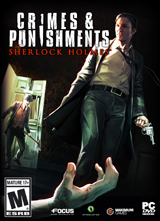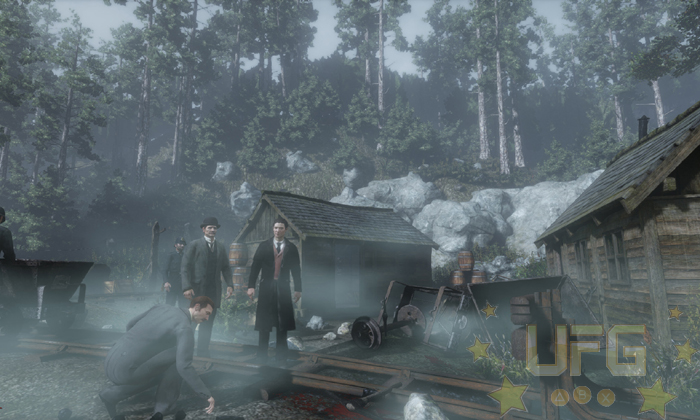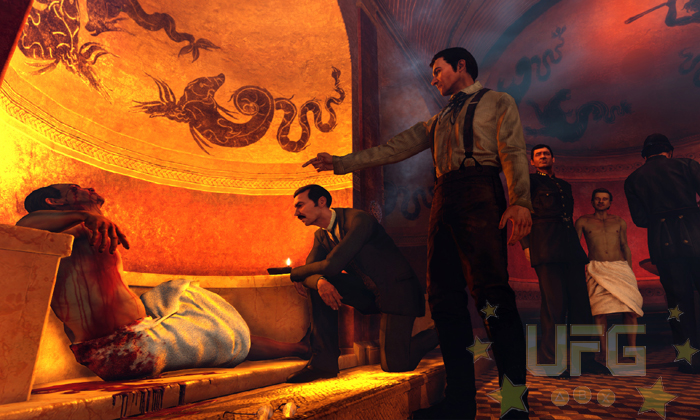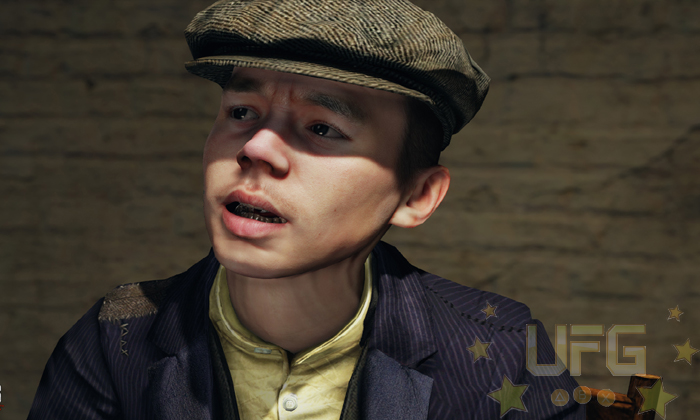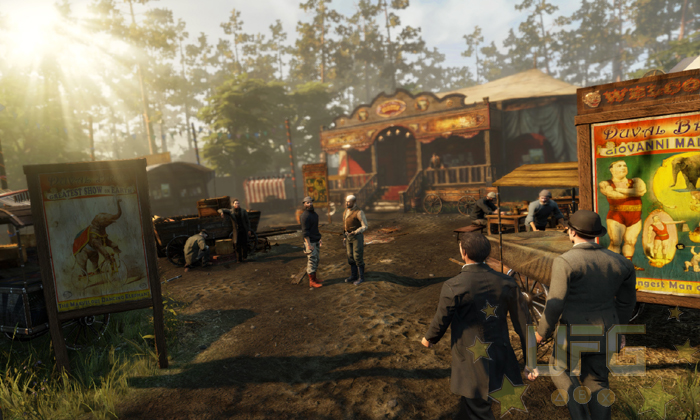Sherlock Holmes: Crimes & Punishments
I remember the first time I played Rocksteady’s Batman: Arkham Asylum. As it was easily the best Batman game I’d ever played, it was the closest I could get to being the Dark Knight without actually losing my parents and donning a cowl. The same can be said for Frogwares’ Sherlock Holmes: Crimes & Punishments – it’s the first time I felt like I was the Baker Street detective!
Crimes & Punishments is all about solving six crimes as Sherlock Holmes in 19th century London. This is done by investigating each crime scene, interviewing witnesses, examining collected evidence, and more. If you’ve played the previous titles in the series you’d know what to expect on a basic level. Clues found via an investigation can be grouped together to deduce what might have happened. Forming the proper conclusion progresses the story– selecting a suspect and motive may lead to an arrest. Crimes & Punishments uses the same formula as the previous games but with a few twists, making it a stand out title within the series.
The first thing that players will notice is that it’s possible to miss clues. In the last game, players could use a sixth sense ability to highlight items to interact with in a given location. In C&P, that ability has been limited to certain instances; there may be something that the police overlooked that you can see using this ability. The icon suggesting that you use this ability may become available after entering a room. Once activated, your surrounding will fade to shades of gray while certain items will be highlighted in gold. For example, a dusty shelf with a clean spot in the shape of a square may indicate that there was once a box or chest sitting there. Turing on this ability will highlight that area, allowing you to take a closer look.
All of the other clues have to be found on your own. Sometimes that means picking up items of interest and looking them over to find any useful information. Other times, clues can be found via conversations with witnesses or suspects. It’s important to be thorough as a missed clue could send you down the wrong deductive path. This brings me to a new mechanic introduced in C&P. Sherlock Holmes can identify certain character traits just by looking someone over. During a conversation, players can pause the interaction to study the individual. Rough hands, moderately expensive yet tattered clothes, unshaven and scared face – you may be talking to a sailor who once made a decent living. Learning these things could help in determining who’s telling you the truth or just provide more dialogue options; I wouldn’t have known to ask this person about a mysterious ship if I didn’t first know that they used to be a sailor.
Another aspect that fans will notice is that you aren’t always doing the same things. The range of crimes is decent enough to offer up unique gameplay experiences, all within the same game. At one point you’re trying to figure out who pinned a man to a wall using a harpoon, the next you’re searching for a train that vanished moments before stopping at a station. Along with these crimes comes an assortment of mini-games to help you find clues. Using your dog to follow a sent, solving a puzzle to pick a lock, mixing chemicals to recreate a poison – you name it, Sherlock does it.
There are many other interesting mechanics and systems that are worth noting, but what I really liked about C&P is that you can fail at being a good detective. Unlike other games of this ilk (L.A Noire I’m looking at you) it is possible to screw up royally, allowing the guilty party to get away. More important than that is the possibility of condemning the wrong people. On paper this might seem like a bad thing but in practice it actually makes this game one of the best in this genre. There is a certain level of ownership given when your choices can directly affect so many lives.
What’s frightening is just how easy it is to nab the wrong person. Because of how well constructed each crime is, even with all the clues discovered you may end up picking the wrong suspect. One particular case early in the game had multiple suspects that were present the night of the crime. The evidence had me leaning towards one character more than the others; my deductions formed a plausible motive and means to which my suspect could have committed the crime. The lack of an alibi and a shaky history didn’t help their situation. In an effort not to spoil things, I’ll just say that my first choice (despite the overwhelming evidence) was wrong. What I found out was that I had to look at everything surrounding a crime in order to correctly identify the culprit. This included things that weren’t necessarily highlighted by Sherlock Holmes or included as clues. Essentially, it was my own mental capabilities and detective skills that would lead me to successfully solve a crime. The evidence may say that a person did something, but were they physically capable of pulling it off? Did they have the background knowledge or smarts required to set up something sinister? Were they present during the crime or did they stumble upon it, accidentally leaving incriminating evidence? There is always a lot to think about!
Once you’ve decided on who did what, you then have to decide their punishment. Not in a vigilante type of way. More so, you have to pick how harsh you’re going to be. “Should you throw the whole book at them or just the abridged version? Heck, in some cases you can even turn a blind eye, telling inspector Lestrade that you couldn’t solve the case. When it comes to these problems, there aren’t any wrong or right answers as it’s more of a moral thing but it still holds weight. Reading up on how the victim is doing after a missed convection could make you second guess your choices (or at the very least feel uncomfortable about how things went down).
Quite frankly, the idea that I could send the wrong person to the gallows is a bit disturbing. Frogwares probably felt the same way because they made it possible to check your results and see if you picked the right suspect. They also allow you to change your mind by reloading the point right before you made your choice. The developer won’t flat out say who committed the crime but this feature does take the edge off a little. Of course, it’s up to you if you want “spoil” the game by knowing if you picked the right suspect. You could continue on to the next chapter without ever taking a second look.
For a game like this, all of the cool mechanics and tense decision-making wouldn’t matter if the world didn’t seem real. Thanks to some highly detailed graphics and awesome voice work, it’s easy to get sucked into C&P. Visually, it’s possible to identify subtle blemishes on a person’s hand (possible bruising) after a fight or how flushed their face is after having too much to drink. I do find fault with how dead some of the character’s eyes look though. They seemed to be rendered good enough to look real but not good enough to look alive; an uncanny valley issue that a lot of games suffer from. Most of the animations were well done, with people realistically opening and closing their hands as they gesture during a conversation. I did have some trouble maneuvering through tight spaces – Sherlock’s floaty movement can be frustrating when trying to line oneself up to get a better close up view of something. There’s also some clipping and frame rate drops when loading new environments but nothing that’ll keep you from playing.
There is a lot more to talk about when it comes to C&P. What you need to know though is that it’s an outstanding adventure game. There are some issues here and there – notably a disguise mechanic that is criminally underused and the aforementioned visual snafus. I had a great time playing as Sherlock Holmes and can’t wait to see how Frogwares evolves the series from here!
Gameplay:
9
Playing a detective (other than Batman) has never been this fun.
Graphics:
8
The proof is in the details. Though there are some issues when it comes to animations and drops in frame rate.
Sound:
10
The voice work was great; everyone sounded genuine.
Replay Value:
6
Though it is possible to replay cases, once you’ve figured out who did what, there isn’t much reason to go back through the game. Even if you wanted to go back and pick a different suspect, you’ll know where all of the clues are and breeze through the game. This is one area that could be helped via DLC though.
Final Score:
8.3
